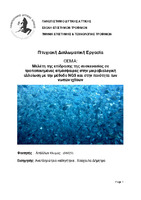Μελέτη της επίδρασης της συσκευασίας σε τροποποιημένες ατμόσφαιρες στην μικροβιολογική αλλοίωση με την μέθοδο NGS και στην ποιότητα των νωπών ιχθύων
Next-generation sequencing characterization of skin, gills, and gut bacterial microbiome of farmed gilthead seabream as a function of packaging

Keywords
NGS ; MAP ; Sea bream ; Aquaculture ; Fish processingAbstract
Ολόκληρη η τσιπούρα συσκευάστηκε (α) αερόβια (AIR) σε φελιζόλ από πολυστυρένιο με επαρκή ποσότητα πάγου, με βάση τις συμβατικές πρακτικές και (β) υπό τροποποιημένη ατμόσφαιρα (συγκέντρωσης 60% CO2, 30% N2, 10% O2). Η Next-Generation Sequencing (NGS) του μικροβιακού φορτίου των ψαριών στο δέρμα, τα βράγχια και τα έντερα πραγματοποιήθηκε στα αρχικά δείγματα (συσκευασία, 1 ημέρα μετά τη εξαλίευση) και στο τέλος (τέλος της διάρκειας ζωής). Το τέλος της διάρκειας ζωής αξιολογήθηκε από μια αισθητηριακή αξιολόγηση που πραγματοποιήθηκε από μια ομάδα εμπειρογνωμόνων. Τα αποτελέσματα του NGS έδειξαν σημαντικές διαφορές στον πλούτο και την ποικιλομορφία των οικογενειών μεταξύ των δύο τύπων συσκευασιών (δηλ. AIR και MAP), καθώς και μεταξύ των τύπων συσκευασίας και του αρχικού μικροβίου της τσιπούρας.
Οι αναλύσεις NGS των μικροβίων, σε επίπεδο Phylum, έδειξαν ότι τα πιο ανθεκτικά βακτήρια, τόσο στο αρχικό μικρόβιο όσο και στο τέλος της διάρκειας ζωής, ήταν τα Πρωτεοβακτήρια, είτε σε δείγματα AIR είτε MAP. Όσον αφορά τα μικρόβια του δέρματος τσιπούρας, οι αρχικά επικρατούσες οικογένειες ήταν Comamonadaceae, Enterobacteriaceae και Moraxellaceae, ενώ στα έντερα επικράτησαν Comamonadaceae, Anaplasmataceae, Bacillaceae και Enterobacteriaceae. Οι αναλύσεις έδειξαν συσχετισμούς μεταξύ του δέρματος και των εντερικών μικροβίων.
Μέχρι το τέλος της διάρκειας ζωής των ψαριών, η σύνθεση του αρχικού μικροβίου τροποποιήθηκε και στους δύο τύπους συσκευασίας (AIR, MAP). Σε γενικές γραμμές, αρκετές από τις αρχικά κυρίαρχες οικογένειες έχουν αντικατασταθεί εν μέρει ή πλήρως από ψυχρότροφες και ψυχρόφιλες οικογένειες όπως Pseudoalteromonadaceae, Psychromonadaceae και Shewanellaceae. Ωστόσο, υπήρχαν οικογένειες, όπως το Comamonadaceae, που παρέμηναν υπό συνθήκες MAP.
Μέχρι την 8η ημέρα της ισοθερμικής αποθήκευσης στους 0 ° C τα ψάρια κάτω από MAP παρουσίασαν υψηλότερη βαθμολογία αισθητηρίων από τα αντίστοιχα δείγματα AIR, υποδεικνύοντας καλύτερη διατήρηση των ποιοτικών χαρακτηριστικών των ψαριών υπό MAP.
Abstract
Whole gilthead seabream was packed (a) aerobically in polystyrene boxes with an adequate quantity of flake ice, based on the conventional practices (AIR) and (b) under modified atmospheres (MAP: 60% CO2, 30% N2, 10% O2). Next- Generation Sequencing (NGS) analysis of fish microbiome on skin, gills, and intestines was performed at the initial (packaging, 1 day after harvesting) and final (end of shelf life) points. End of shelf life was assessed by a sensory evaluation carried out by a panel of experts.
NGS results indicated statistically significant differences in families’ richness and diversity among the two types of packaging (i.e. AIR and MAP) as well as among the packaging types and the initial seabream’s microbiome. The NGS analyses of the microbiota, at the Phylum level, showed that the most persistent bacteria, both at the initial microbiome and at the end of shelf life, was Proteobacteria, either in AIR or MAP samples. As regards gilthead seabream skin microbiota, the initially prevailing Families were Comamonadaceae, Enterobacteriaceae, and Moraxellaceae while on the intestines prevailed Comamonadaceae, Anaplasmataceae, Bacillaceae, and Enterobacteriaceae.
Statistical analyses indicated positive correlations between the skin and intestinal microbiota. By the end of fish shelf life, the composition of the initial microbiome was modified in both types of packaging (AIR, MAP). In general, several of the initially predominant families have been partially or completely replaced by psychotropic and psychrophilic families like Pseudoalte- romonadaceae, Psychromonadaceae, and Shewanellaceae. However, there were families, such as Comamonadaceae, persistent under MAP conditions. By the 8th day of isothermal storage at 0°C fish under MAP exhibited higher sensory scorings than the respective AIR samples, indicating better retention of quality attributes of fish under MAP.

